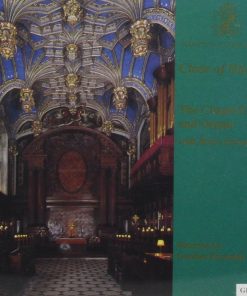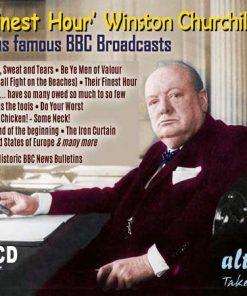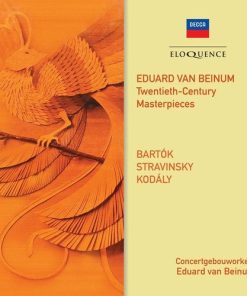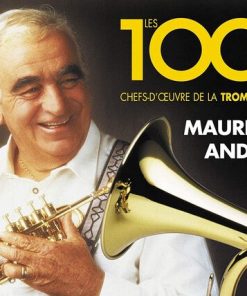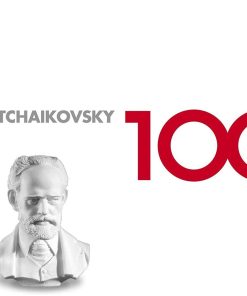RACHMANINOV: Symphony No. 3; “Youth” Symphony; Piano Concerto No. 4 – Ashkenazy, Previn, Kletzki DECCA
$ 3,00 $ 1,80

Sergei Rachmaninov began his Third Symphony in August 1935 at Senar, his Swiss villa, while riding a final wave of popular success. His ‘Rhapsody on a Theme of Paganini’ had enjoyed a successful premiere the year before, and subsequent performances had gone far to mute criticism that the composer’s well of inspiration had dried up.
Still active as a touring concert pianist – although experiencing more and more health problems – the sexagenarian composer was able to complete two movements of his new symphony before the 1935-36 concert season interrupted him. It wasn’t until May 1936 that he was able to finish his last symphony. The premiere was given by Leopold Stokowski and the Philadelphia Orchestra – previously a lucky team for Rachmaninov – on 6th November, 1936.
Unfortunately, the new symphony received only a lukewarm reception. Listeners who were hoping for more heart-swelling lyricism in the style of the ‘Paganini Rhapsody’ (its eighteenth variation, in particular) found the new symphony too forbidding; progressive critics disliked its regretful and (some said) reactionary manner and, in essence, found it not forbidding enough. Rachmaninov tried not to show his disappointment too keenly, and effected revisions (mostly cuts) in 1938. Nevertheless, the less than enthusiastic response to his Third Symphony well may have stifled his creative urge in the years that remained to him; apart from the ‘Symphonic Dances’ (written in 1940), it was his last composition of any import.
But what wonderful import! While the Second Symphony still may enjoy greater popular appeal, the Third Symphony demonstrates how much Rachmaninov’s talents had matured in the nearly thirty intervening years. Gone are the excesses – of both length and emotion – found in the Second Symphony; the Third Symphony is concise and kept firmly under rein by the composer. Dispensing with traditional four-movement construction, he inserts his somewhat diabolically sparkling scherzo into the middle of the slow second movement. In the Third, the orchestration is less thick, and the harmonic and melodic developments are less predictable. Still, the composer’s fingerprints are everywhere: the symphony touches on human emotions from one extreme to another, and the melodies, at their best, are memorable without turning vulgar. As in so many of his works, the ‘Dies Irae’, that sinister and apocalyptic plainchant, makes an appearance – here, in the first and last movements.
Not everyone agrees about the merits of the Third Symphony. In his biography of the composer, John Culshaw calls it ‘not a satisfactory symphony’ – a comment that seems more personal than absolute. However, Culshaw’s other comments about the symphony’s mood are insightful. ‘One aspect of this symphony must be stressed more than any other,’ he writes, ‘and that it its remarkable bitterness … It is as though Rachmaninov, having created melodies as good and as beautiful as anything he had written before, turned on to them the savage light of his technique for purposes quite alien to his nature.’
As its name suggests, the so-called ‘Youth’ Symphony comes from the other end of the composer’s career. He completed it in 1891, while still a teenager, to satisfy the graduation requirements of the Moscow Conservatoire. The symphony – more accurately, a symphonic movement – remained unpublished until the 1940s. (Oscar von Riesemann’s early biography of the composer suggests that there were, in fact, additional movements, but these have not survived.) Much of this eleven-minute movement looks over its shoulders at Tchaikovsky, and some of it looks forward to Rachmaninov’s Second Symphony. (There is a ‘family resemblance’ between the openings of both symphonies.) According to Riesemann, Rachmaninov’s mentors were unimpressed, and not even the composer had any use for his premature child, except perhaps to cannibalize it, like Saturn, later in life. Nevertheless, as is the case with many ‘youthful’ things, its naïveté gives it charm, and its indiscretions can easily be forgiven in a symphony so short!
The last of Rachmaninov’s four piano concertos gave him the greatest trouble, and it never has achieved the popularity of its predecessors. Completed in 1926 and premiered a year later (again by Stokowski and the Philadelphia Orchestra, with the composer at the piano), Rachmaninov actually may have started sketching the work as early as 1913. There are indications that the concerto originally was to have been a large-scale work – reviewing an early draft, the composer quipped that has new concerto would have to be performed over the course of several evenings, just like Wagner’s Ring.
A successful premiere was particularly important to the composer, as the new concerto was to be his first major ‘American’ work. The critics burst his bubble. Pitts Sanborn in The Evening Telegram called the concerto ‘long-winded, tiresome, unimportant [and] in some places tawdry.’ Sanborn also complained that the concerto was derivative, a ‘hodgepodge of this and that, all the way from Liszt to Puccini, from Chopin to Tchaikovsky. Even Mendelssohn enjoys a passing compliment.’ (Mendelssohn?) At the London premiere, it was noted that second movement’s main theme bore a laughable resemblance to ‘Three Blind Mice.’ (The composer himself complained that this same passage sounded too much like a theme from Schumann’s Piano Concerto.) Cuts and revisions made after the Philadelphia premiere, and again in 1941, did little to change listeners’ minds about the Fourth Concerto. Culshaw repeatedly refers to it as ‘inferior.’
The Fourth Concerto may contain some miscalculations on the part of the composer, but some of the blame for its lack of success must be attributed to listener prejudice. The piece eschews the rapturously adversarial heroics of the Second and Third Concertos in favour of more organic and integrated musicianship. Composer Kaikhosru Sorabji, comparing it to the Third Concerto, wrote, ‘the Fourth Concerto is a stark, rather bare and gaunt work that comes in style and treatment rather within the domain of the ‘sinfonia concertante’ than the concerto in the proper sense.’ Biographer Barrie Martyn is equally perceptive when he writes, ‘What audiences expected and wanted was a wholly different concerto from the one Rachmaninov wrote; what he gave them is a work of considerable originality in an unfamiliar vein, a work which, though uneven, has several memorable moments of real inspiration.’
Raymond Tuttle

Kletzki’s is one of the finest-ever recordings of the Third Symphony … unabashedly romantic … An excellent release’ ClassicsToday
‘A superb issue – don’t hesitate – buy it and enjoy – you won’t regret it’ MusicWeb

SERGEI RACHMANINOV
‘Youth’ Symphony in D minor
Concertgebouw Orchestra
Vladimir Ashkenazy
Symphony No. 3 in A minor, Op. 44
L’Orchestre de la Suisse Romande
Paul Kletzki
Piano Concerto No. 4 in G minor, Op. 40
Vladimir Ashkenazy, piano
London Symphony Orchestra
André Previn
Fast Shipping and Professional Packing
Due to our longstanding partnership with UPS FedEx DHL and other leading international carriers, we are able to provide a range of shipping options. Our warehouse staff are highly trained to pack your goods exactly according to the specifications that we supply. Your goods will undergo a thorough examination and will be safely packaged prior to being sent out. Everyday we deliver hundreds of packages to our customers from all over the world. This is an indication of our dedication to being the largest online retailer worldwide. Warehouses and distribution centers can be located in Europe as well as the USA.
Orders with more than 1 item are assigned processing periods for each item.
Before shipment, all ordered products will be thoroughly inspected. Today, most orders will be shipped within 48 hours. The estimated delivery time is between 3-7 days.
Returns
The stock is constantly changing. It's not entirely managed by us since we are involved with multiple parties such as the factory and our storage. The actual stock can fluctuate at any time. Please understand it may happen that your order will be out of stock when the order is placed.
Our policy is valid for 30 days. If you haven't received your product within 30 days, we're not able to issue either a return or exchange.
You are able to return a product if it is unused and in the same condition when you received it. It must also still remain in the original packaging.






